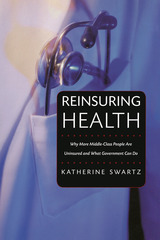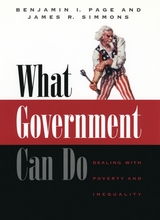2 books about What Government Can Do

Reinsuring Health
Why More Middle-Class People Are Uninsured and What Government Can Do
Katherine Swartz
Russell Sage Foundation, 2006
America's current system of health insurance, which relies almost exclusively on employer-sponsored coverage, is in danger of collapse, and this problem is not limited to the poor and working class. An increasing number of middle class Americans do not have employer-provided insurance and—due to skyrocketing premiums—cannot afford to purchase coverage for themselves. Reinsuring Health, by economist Katherine Swartz, examines this growing national crisis and outlines a concrete plan to make health insurance accessible and affordable for all Americans. Reinsuring Health documents why the number of uninsured Americans—now 45.5 million people—has grown in the last twenty-five years. Swartz focuses on how labor market changes—such as the decline of domestic manufacturing, decreased unionization, and the growth of non-standard work arrangements—have led U.S. employers to retreat from providing health insurance for their workers. These trends, combined with the increasing costs of medical care, have led to an explosion in health insurance premiums and a decline in coverage, particularly among the middle-class. Since those who seek insurance as individuals are generally most likely to need health care, private insurers charge higher premiums in the individual (non-group) markets than to people who obtain group insurance. This makes individual health insurance less attractive to the young and increasingly unaffordable for middle-class Americans. Similarly, insurers charge higher per person (or per family) premiums to small firms than to large companies, so many small firms do not sponsor coverage for their employees. Reinsuring Health shows how these problems can be overcome if the federal government provides a new reinsurance program which would protect insurance companies that provide small group and individual health insurance against the possibility that their policy-holders will incur very high medical expenses. By assuming some of the risk that people will face extremely costly medical bills, the government will make insurers less hesitant to offer coverage to high-risk individuals, and will help drive down premiums for others. Reinsuring Health demonstrates that this form of government reinsurance has worked in the past, helping to establish smooth running private markets for catastrophe insurance and secondary mortgages. Today, growing numbers of middle class Americans lack health insurance. Protection against the possibility of falling ill or getting hurt and having to pay extraordinary health care bills should not be a luxury available only to the very rich and the very poor. Reinsuring Health proposes a straightforward solution that would bring health insurance back within the reach of the increasing ranks of the uninsured, particularly those who are in the middle class.
[more]

What Government Can Do
Dealing with Poverty and Inequality
Benjamin I. Page and James R. Simmons
University of Chicago Press, 2000
It is often said that the federal government cannot or should not attempt to address America's problems of poverty and inequality—because its bureaucracy is wasteful or its programs ineffective. But is this true? In this book, Benjamin I. Page and James R. Simmons examine a number of federal and local programs, detailing what government action already does for its citizens and assessing how efficient it is at solving the problems it seeks to address. Their conclusion, surprisingly, is the polar opposite of the prevailing rhetoric—What Government Can Do is an insightful and compelling argument that it both can and should do more.
[more]
READERS
Browse our collection.
PUBLISHERS
See BiblioVault's publisher services.
STUDENT SERVICES
Files for college accessibility offices.
UChicago Accessibility Resources
home | accessibility | search | about | contact us
BiblioVault ® 2001 - 2024
The University of Chicago Press









